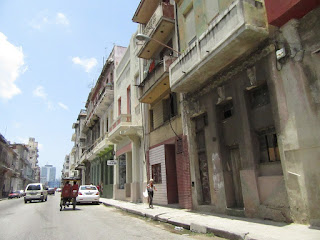San Lazaro begins in Old Havana at Paseo de Marti, it crosses Centro Habana and ends in the Municipality of Plaza de La Revolucion at Calle L in front of the steps leading to the Havana University (Runs East to West for 21 blocks). The name of the street comes from the hospital that was founded in 1746, Hospital de San Lázaro, which at it's inception started out as mostly a service to leprosy patients. It had been given different names through the years; Calle Ancha del Norte, El Basurero, Avenida Antonio Maceo & Avenida de la República, until being restored once again to San Lázaro in 1936 by the Havana City Council.
San Lazaro was a main avenue of transit to the first public burial place in Havana, the Espada Cemetery, which was opened in 1806 (closed by 1878). However, the street wasn't populated until 1815 and the backs of those houses overlooked the ocean....the Havana seawall that exists today wasn't built until the early 20th century. Needless to say, houses along this stretch suffered greatly during hurricanes. It was one of the most important streets in Havana during colonial times.
Today, parts of San Lazaro have been put on the priority list for conservation by the Office of the City Historian as there are many important buildings along it's route that are worth rehabilitation. Some places of interest along SanLazaro are; The University of Havana, Los Mártires Park, the Hermanos Amejeiras Hospital, Maceo Park and the spot where Jose Marti served prison time while still a teenager where in the nineteenth century it was occupied by the San Lazaro quarry.
A very enlightening walk and safe, lots of interesting architecture and where you'll find regular Habaneros going about their daily lives, unlike the rebuilt area of Old Havana which is full of tourists. If you've run out of things to do or are looking for something different, I recommend you take a stroll along this street.
Keep in mind, it was extremely difficult choosing the pictures for this post....I had more than 100 to choose from and I still ended up posting more than I usually do. I think I might create another post with a bunch of pictures that didn't make this cut....perhaps next month. I hope you enjoy.
San Lazaro was a main avenue of transit to the first public burial place in Havana, the Espada Cemetery, which was opened in 1806 (closed by 1878). However, the street wasn't populated until 1815 and the backs of those houses overlooked the ocean....the Havana seawall that exists today wasn't built until the early 20th century. Needless to say, houses along this stretch suffered greatly during hurricanes. It was one of the most important streets in Havana during colonial times.
Today, parts of San Lazaro have been put on the priority list for conservation by the Office of the City Historian as there are many important buildings along it's route that are worth rehabilitation. Some places of interest along SanLazaro are; The University of Havana, Los Mártires Park, the Hermanos Amejeiras Hospital, Maceo Park and the spot where Jose Marti served prison time while still a teenager where in the nineteenth century it was occupied by the San Lazaro quarry.
A very enlightening walk and safe, lots of interesting architecture and where you'll find regular Habaneros going about their daily lives, unlike the rebuilt area of Old Havana which is full of tourists. If you've run out of things to do or are looking for something different, I recommend you take a stroll along this street.
Keep in mind, it was extremely difficult choosing the pictures for this post....I had more than 100 to choose from and I still ended up posting more than I usually do. I think I might create another post with a bunch of pictures that didn't make this cut....perhaps next month. I hope you enjoy.












































No comments:
Post a Comment